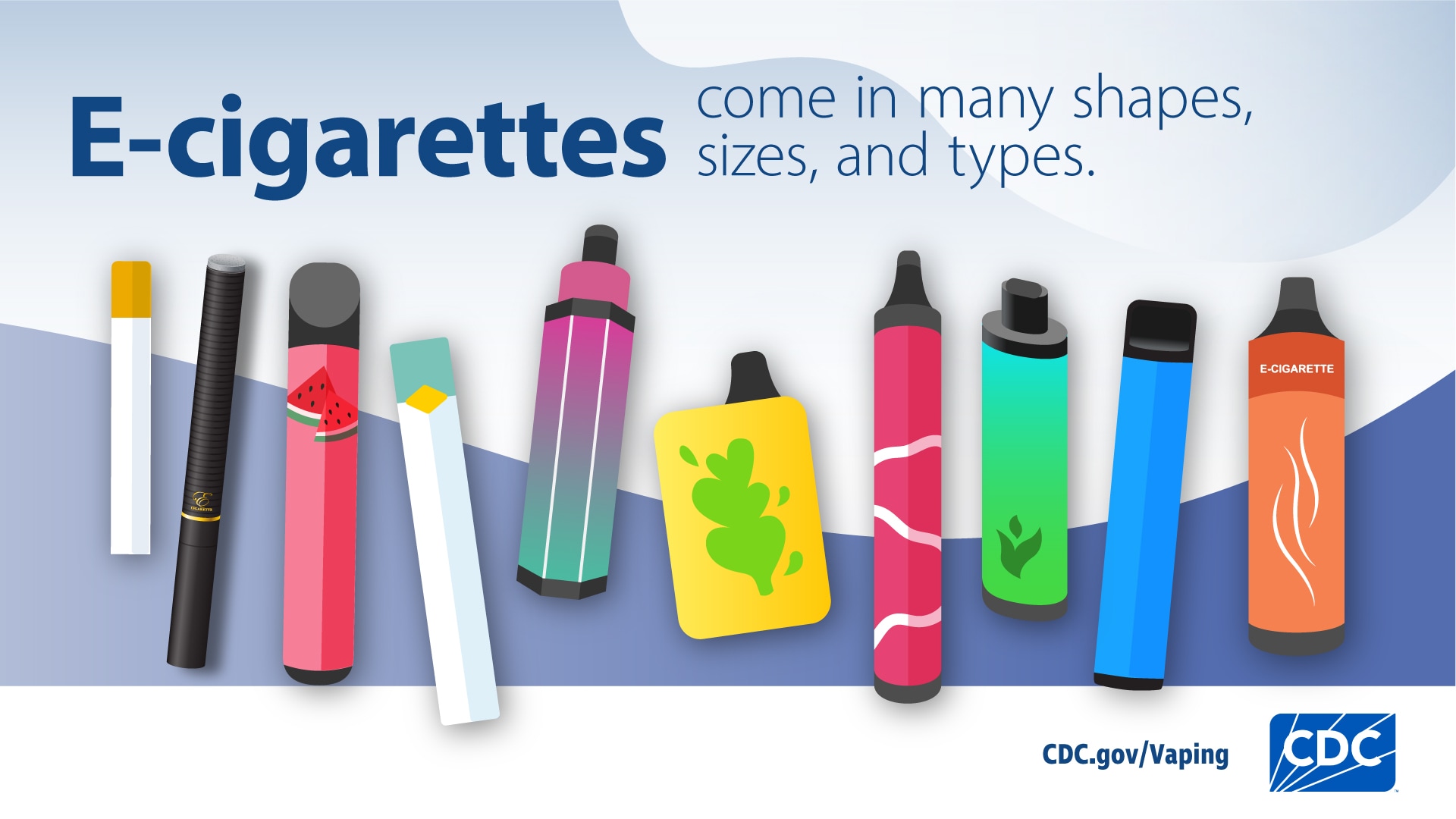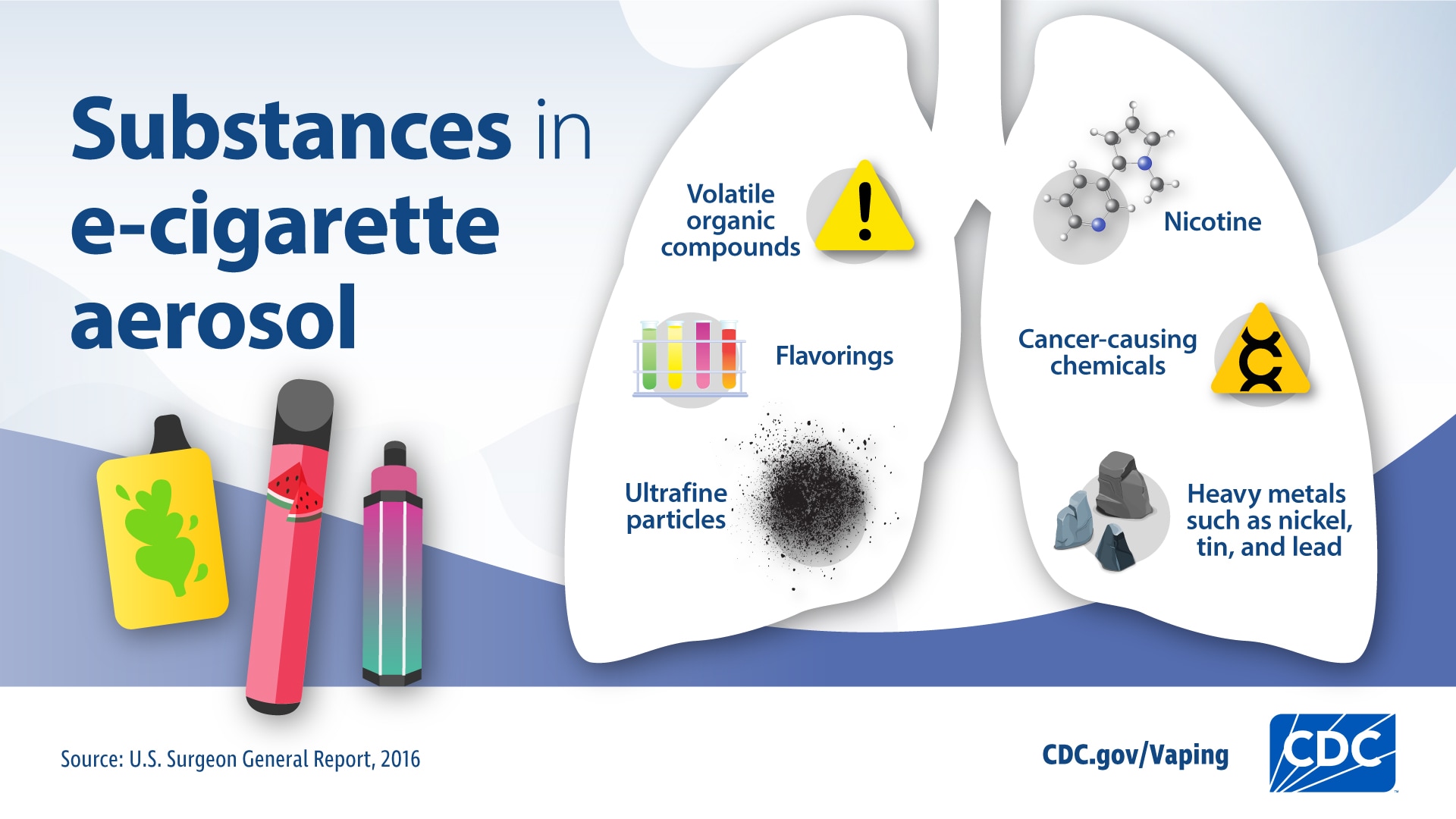At a glance
E-cigarettes, also known as vapes, are battery-operated devices that heat a liquid and produce an aerosol. They come in many shapes and sizes, and they typically contain nicotine.
E-cigarettes (vapes)
- E-cigarettes, also known as vapes, are battery-operated devices that heat a liquid and produce an aerosol. An aerosol is a mix of small particles released in the air. Some people refer to the aerosol from an e-cigarette as "vapor."
- A person using an e-cigarette inhales this aerosol into their lungs. Bystanders can also breathe in the aerosol when the person using the e-cigarette breathes the aerosol out.
- E-cigarettes typically contain nicotine, the addictive substance in cigarettes and other tobacco products. Some e-cigarettes can also be used to deliver cannabis and other drugs.
- E-cigarettes often come in bright colors. They are also available in flavors that appeal to young people, like fruit, candy, menthol, and mint.
- People often refer to using e-cigarettes as "vaping."
Different types of e-cigarettes
- E-cigarettes come in many shapes and sizes. Most have a battery, a heating element, and a place to hold a liquid.
- There are many types of e-cigarettes, including disposable devices, refillable devices, and devices with pre-filled cartridges or pods.
- Disposable e-cigarettes come pre-filled and may be rechargeable. They are not designed to be refilled.
- Refillable e-cigarettes are rechargeable and have a tank or chamber that is filled with e-liquid. Some refillable devices can be modified to change the amount of aerosol produced or the strength of the delivered substance.
- E-cigarettes with a pre-filled cartridge or pod are rechargeable and intended for reuse.
- Disposable e-cigarettes come pre-filled and may be rechargeable. They are not designed to be refilled.
- Some e-cigarettes look like USB flash drives, pens, smartphones, highlighters, toys, and other types of products.
- Some e-cigarettes have features similar to those found in smartphones. These so-called “smart vapes” have digital display screens and can include games and reward systems for vaping, such as points and rankings. These features may make the products even more appealing to youth.
- E-cigarettes are sometimes called e-cigs, vapes, vape pens, and electronic nicotine delivery systems (ENDS). Youth may use different terms for vapes or refer to them by their brand names.
- The liquid in e-cigarettes is sometimes called e-juice, e-liquid, vape juice, or vape liquid.
For more information about different types of devices, see the E-Cigarette, or Vaping, Products Visual Dictionary.

Substances found in e-cigarettes and their aerosol
E-cigarette aerosol is NOT harmless “water vapor.” It can contain harmful and potentially harmful substances, including:1
- Nicotine, a highly addictive chemical that can harm adolescent brain development
- Cancer-causing chemicals
- Heavy metals such as nickel, tin, and lead
- Tiny particles that can be inhaled deep into the lungs
- Volatile organic compounds
- Flavorings such as diacetyl, a chemical linked to a serious lung disease. Some flavorings used in e-cigarettes may be safe to eat but not to inhale because the lungs process substances differently than the gut.
It is difficult to know which substances e-cigarettes contain. For example, some e-cigarettes marketed as containing zero percent nicotine have been found to contain nicotine.2
Many e-cigarettes contain nicotine salts. These allow people to consume high levels of nicotine without experiencing the harshness of freebase nicotine.3

E-cigarette sales in the United States
The types of e-cigarette products that are available and being sold changes rapidly. Multiple factors affect e-cigarette sales. These include the introduction of new products to the market, local and state policies regarding sales, actions undertaken by the Food and Drug Administration (FDA), and changes in global supply chains.
The following describes changes in e-cigarette unit sales between February 2020 and June 2024, based on 4-week periods. During this time, e-cigarette unit sales increased from 15.7 million units to 21.1 million (34.7% increase). Sales data are from brick-and-mortar retailers only (online and tobacco specialty store sales were unavailable).4
- As of June 2024, nearly 6,300 different e-cigarette products are available for purchase in the United States. Disposable e-cigarettes in youth-appealing flavors are the most commonly sold device type.
- In June 2024, 58.1% (12.3 million units) of all e-cigarette sales were disposable e-cigarettes; the rest were prefilled cartridges or pod-based e-cigarettes.
- Between February 2020 and June 2024, the percentage of disposable e-cigarettes sold more than doubled from 26.0% to 58.1%. In that same time period, the percentage of prefilled cartridges decreased from 73.9% to 41.8%.
- In June 2024, 80.6% (17.0 million units) of e-cigarette sales were for flavors other than tobacco, such as menthol, mint, or other flavors.
- In June 2024, e-cigarette dollar sales totaled $488.9 million.
- From April to June 2024, the 10 top-selling e-cigarette brands (in descending order by dollar sales) were Vuse, JUUL, Geek Bar Pulse, Breeze Smoke, NJOY, RAZ, HQD, Loon Maxx, Breeze Prime, and Juicy Bar.
- U.S. Dept of Health and Human Services. E-Cigarette Use Among Youth and Young Adults: A Report of the Surgeon General. Centers for Disease Control and Prevention; 2016. Accessed Feb 14, 2024. https://www.cdc.gov/tobacco/data_statistics/sgr/e-cigarettes/pdfs/2016_sgr_entire_report_508.pdf
- Goniewicz ML, Gupta R, Lee YH, et al. Nicotine levels in electronic cigarette refill solutions: a comparative analysis of products from the U.S., Korea, and Poland. Int J Drug Policy. 2015;26(6):583–588.
- Leventhal AM, Madden DR, Peraza N, et al. Effect of exposure to e-cigarettes with salt vs free-base nicotine on the appeal and sensory experience of vaping. JAMA Netw Open. 2021;4(1):e2032757.
- CDC Foundation. Monitoring U.S. E-Cigarette Sales: National Trends. Accessed October 3, 2024. https://tobaccomonitoring.org/national/
